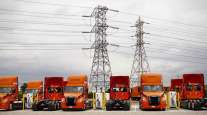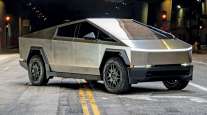Managing Editor, Features and Multimedia
Early Adopters of Electric Trucks Say Planning, Partnerships Are Crucial

[Stay on top of transportation news: Get TTNews in your inbox.]
Truck makers are beginning to introduce battery-electric models, but successfully deploying this new breed of commercial vehicle requires fleets to manage a bevy of new considerations, including installation of charging equipment, coordination with utility companies and exploring government incentives.
Fleet and OEM executives addressed these important aspects of electric truck adoption during an Oct. 22 educational session at American Trucking Associations’ Management Conference & Exhibition, held virtually this year due to the ongoing coronavirus pandemic.
Paul Rosa, senior vice president of procurement and fleet planning at Penske Truck Leasing, encouraged fleets interested in deploying electric trucks to “plan, plan and plan again.”
As one of the first steps, fleets must identify locations to install their charging stations and envision how the electric vehicles will interact with existing operations.
Infrastructure design, permitting and construction all can be time consuming, so it’s important to engage with municipalities and utility companies very early in the process, Rosa said.
“Don’t wait for the trucks to be here to start your infrastructure discussion,” he said. “If you do, you’ll be way behind.”

Jim O'Leary by Transport Topics
Fleet electrification is far more complex than today’s process of simply ordering new diesel trucks and placing them in service several months later, said Jim O’Leary, vice president of fleet services at NFI Industries.
Deploying electric trucks requires engagement with many partners and dealing with new contracts for items such as engineering and load-management software, he said.
Together, Penske and NFI have been operating 30 battery-electric Freightliner eCascadia and medium-duty eM2 models through a partnership with Daimler Trucks North America.
DTNA also has built eight additional electric trucks that it plans to rotate through a number of other fleet customers over the next two years so they, too, can gain hands-on experience with electric vehicles in their own freight operations.

Jed Proctor by Transport Topics
That learning experience will help pave the way for full production and broader adoption, said Jed Proctor, DTNA’s manager of customer consulting for e-mobility.
Government incentives for electric vehicle purchases, infrastructure installation and electric vehicle operation also can accelerate electric truck adoption by helping to offset the cost of the new technology, Proctor said.
Driver feedback on the electric trucks has been largely positive, according to the two fleets.
Rosa said the eCascadia has gotten high marks for vehicle performance, including torque, acceleration and drivability, especially in high winds due to the vehicle’s low center of gravity with the batteries mounted under the frame rails.
Meanwhile, less obvious benefits such as quiet operation and less vibration can help reduce driver fatigue. Some drivers even remarked that they don’t smell like diesel at the end of the day.
“They are thrilled with this technology and not eager to go back to diesel,” said Craig Sieber, Penske’s manager of new products.
Some drivers, however, have said they would like to see the same number of options and features that are available in diesel models, including more “creature comforts” in the cab or details such as automatically silencing the radio while backing up, for example.
Energy management is another core consideration for electric fleet operations.

Nate Hill by Transport Topics
“This can make a big difference in your total cost of ownership of electric vehicles,” said Nate Hill, head of charging infrastructure at DTNA.
The cost of electricity is based not only on total power consumed, but also on peak demand charges.
One way to reduce expenses is through smart-charging software that can delay vehicle recharging until hours when prices are lower rather than incurring peak charges.
When designing charging stations for their depots or yards, fleets also will need to choose from many different types of charging equipment that come with a range of different installation costs, power capacity and charging times.

Craig Sieber by Transport Topics
Fleets said they still are working to perfect the charging process by working through issues such as software updates preventing a truck from accepting a charge when plugged in.
“Any software updates need to be coordinated and tested immediately before we assume everything’s good,” Sieber said.
Even for an early adopter like Penske, there is still a long road ahead to prepare technicians, sales representatives and operations teams to work with these vehicles.
“This is a very exciting space,” Rosa said. “We’re really happy to be on this journey. It’s coming, and it’s coming fast.”
Want more news? Listen to today's daily briefing:
Subscribe: Apple Podcasts | Spotify | Amazon Alexa | Google Assistant | More





